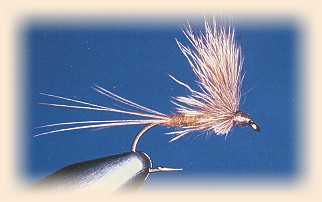March Brown Spundun
Dry Flies with Life Vests
By Art Scheck
The biggest advantage of tying a no-hackle dry fly
is not paying for rooster feathers that cost considerably
more per ounce than gold. For many tiers, that benefit
outweighs the drawbacks of some no-hackle designs:
marginal floatation, poor durability, difficulty of
tying. When one-third of a specially bred chicken can
cost more than a good fly line, fly tiers look for
alternatives to fowl.
That's why I've included this chapter. [See credits
at bottom of this article.] The flies
we're going to examine don't require hackle feathers,
but they avoid the drawbacks of many no-hackle constructions.
They float well, they hold up as well as most dry flies
and better than some, and they're easily tied with cheap
materials. I call them Spunduns, a reference to the
spun deer hair that forms their wings and thoraxes.
In profile, a Spundun resembles the Comparadun style
invented by Al Caucci. But the two flies are built in
entirely different ways. On a Comparadun, the butts of
the wing hair are bound down by thread, adding weight
and bulk to the fly. The butt ends of a Spundun's deer-hair
wing surround the front of the body to become a plump,
buoyant thorax; they function as a miniature flotation
vest. When treated with a good floatant or waterproofing
agent, Spundums float very well and for a very long time.
How long? How does five weeks grab you? That's how long
a test batch of Spunduns remained afloat. Actually, they
never really sank. I finally threw the flies out because
after five weeks in a container of water, they began to
look like a science experiment gone horribly wrong.
A Spundun has only three components: tails, body, and
deer hair. It's a simple construction that progresses from
one end of the hook to the other. Spunduns can be tied to
represent all but the smallest mayflies, and they eliminate
the expense of dry-fly hackle.
The Parts
As they do on most dry flies, stiff, shiny hackle fibers
make good tails on Spunduns. Suitable fibers can come
from large neck hackles (including those from cheap, imported
rooster capes) and strung saddle feathers that don't have
too much web. Other materials also work: calf tail,
woodchuck guard hairs, moose mane, and, on small patterns,
synthetic fibers such as Microfibbetts.
Dubbing is the most versatile body material, though Spunduns
can also have bodies made with peacock herl or stripped quills.
Any of the dubbing suitable for other dry flies will work on a
Spundun. On smaller pattersn, the fine synthetic dubbing are
easier to use. Natural furs should have the guard hairs
removed.
Use fine, soft deer hair for the wing and thorax. Such material
is usually sold as "coastal deer" or Comparadun hair. The tips
of longer hair might work, but they're sometimes too hard to
flare and spin when you tighten the thread. About the only way
to find out is to try hair from various patches of hide.
Most deer hair has dark tips, though the length of the dark
band varies considerably. Try to use hair with the shortest
possible dark area at the tips. After stacking a bundle of
hair, you can trim a little bit off the tips to shorten
the dark band.
Flymaster 6/0, size 8/0 Uni-Thread, and such like threads are
strong enough for tying small Spunduns, which require tiny
bundles of deer hair. On size 14 and larger flies, I
use size 3/0 Monocord or sizr 6/0 Uni-Thread for both their
greater strength and the speed at which they let me build up
the head. The latter item is important, because a Spundun's
head is what props up the deer-hair wing.
Tying a March Brown Spundun
There's only one tying tip for these flies: Leave the front
quarter of the hook shank naked until it's time to add the
deer hair. As long as you do that, you will have no trouble
tying a Spundun.
For our sample fly, let's tie an Eastern March Brown version
of the Spundun. This is a fairly large mayfly, which means
that our imitation has enough room for me to show you another
method of making divided tails. Here's the recipe.
Materials List March Brown Spundun:
Hook: Standard dry fly, size 12.
Thread: Tan 3/0 Monocord.
Tails: Brown or ginger hackle fibers divided by a tiny
ball of dubbing.
Body: Yellowish brown dubbing. The dubbing shown in
the photos is a blend of brown and yellow fur. These mayflies
vary in color from place to place; some are more brown, others
more yellow. If you want to duplicate the color of your local
bugs, you'll have to catch some and study them. Generally, though,
you can get by with a blend of two parts of medium brown material
and one part yellow. On a fly this big, rabbit fur works fine.
Wing and Thorax: Natural deer hair.
Instructions - March Brown Spundun:
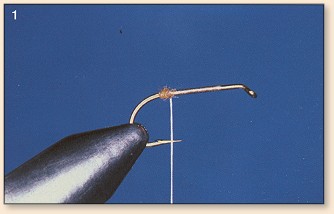
1. Attach the thread one-fourth of the shank length behind
the hook eye; be sure to leave the first quarter of shank
bare. Wrap back to the end of the shank. Twist a tiny
bit of dubbing onto the thread and wrap a small ball of
dubbing at the start of the hook bend.

2. Tie in a few hackle fibers on the near side
of the shank, then tie another few on the far side.
The tiny ball of dubbing keeps the two bunches of
fibers separated, giving the fly forked tails. You
can use this trick on most mayfly patterns.
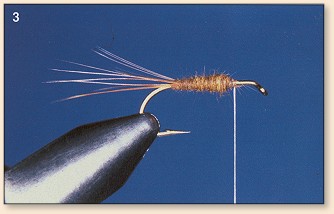
3. Dub the body, stopping at the one-quarter mark
of the hook shank. Build the body with a slight
taper.

4. Clean a small bundle of fine deer hair. Stack the
hair to align the tips. When you separate the halves
of the stacker, do it so that the tips of the hair are
pointing forward, as shown.
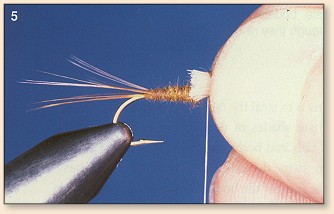
5. Measure the length of the wing. The thread should
interest the hair about one hook-shank length from the
tips. Hold the hair with your fingertips even with the
tie-in spot. Cut the butts straight across about 1/16
inch from your fingertips. Hold the hair atop the hook
and pass the thread bobbin over the hair twice, making two
soft wraps around the butts.
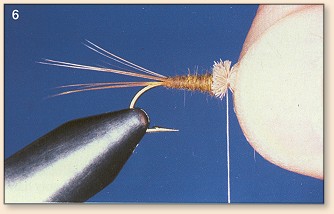
6. Slowly tighten the wraps by pulling the bobbin
straight down. The hair will begin to flare. As the
butts of hair stand up like those in the photo [above]
release your grip on the hair. Tighten the thread all
the way, spinning the hair around the hook. Make another
two or three wraps of thread in the same spot to secure
the hair. The process is like spinning the head of a
Muddler or Fathead Caddis, except that the hair is
backward.
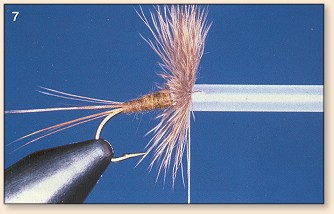
7. You can fold the hair back with your fingers,
but a small tube makes the job easier. This is a
piece of plastic tubing. Slide the tube over the
hook eye and push it against the base of your hair.
Once the hair is roughly perpendicular to the hook,
you can fold it back with your fingertips.
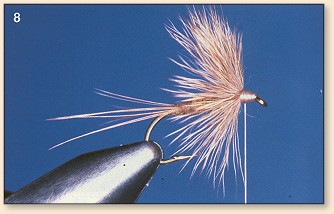
8. Gather all the hair and fold it toward the rear.
Wrap a head against the front of the hair. Be sure
to make a number of wraps right against the base of
the hair; the fly's head is all that keeps the hair
elevated.
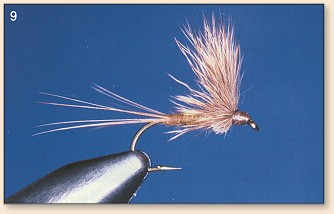
9. Whip-finish the thread. Trim the hair under the
hook to the same length as the butts. Cement the head
and apply a tiny bead of cement to the base of the
wing.
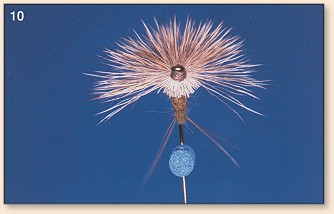
10. The butts and the trimmed hairs form a buoyant
thorax. If the pale color of the thorax bothers you,
tint the hair with a permanent marker. Most mayflies,
however, have pale bodies. This shot also shows the
forked tails, though they're out of the cameras's depth
of field.
Options and Variations
 The easiest way to cook up Spundun patterns is to
steal the tails and bodies of established patterns
and combine them with appropriate shades of deer hair.
For a Light Cahill Spundun, use the standard pattern's
cream tails and body, and make the wing with pale tan
deer hair. To tie a Hendrickson Spundun, swipe the
tails and body of the classic dressing and spin a clump
of dyed-gray hair on the front of the hook. For the wing
of an Adams Spundun, use deer hair with pronounced dark
bars.
The easiest way to cook up Spundun patterns is to
steal the tails and bodies of established patterns
and combine them with appropriate shades of deer hair.
For a Light Cahill Spundun, use the standard pattern's
cream tails and body, and make the wing with pale tan
deer hair. To tie a Hendrickson Spundun, swipe the
tails and body of the classic dressing and spin a clump
of dyed-gray hair on the front of the hook. For the wing
of an Adams Spundun, use deer hair with pronounced dark
bars.
You can also study real mayflies or photos to
determine the best colors of deer hair to use for
wings. On most patterns, though, grayish tan
or dyed-gray hair works well enough to fool fish.
This construction does not lend itself to tying
imitations of the smallest mayflies. I can manage
Spunduns on standard size 16 dry-fly hooks; a
short-shank hook lets me produce a fly roughly
equivalent to one tied on a size 18 standard hook.
That still leaves out some little bugs such as Tricos
and the smaller olive mayflies. I can live with
that. A cheap, simple, buoyant construction that
I can use for better than 90 percent of mayfly
hatches strikes me as a pretty good deal. . . ~ Art Scheck
Credits: From Tying Better Flies,
by Art Scheck, published by The Countryman Press.
We appreciate use permission.
|

